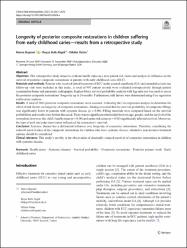| dc.contributor.author | Bayram, Merve | |
| dc.contributor.author | Ballı Akgöl, Beyza | |
| dc.contributor.author | Üstün, Nilüfer | |
| dc.date.accessioned | 2021-10-15T08:46:34Z | |
| dc.date.available | 2021-10-15T08:46:34Z | |
| dc.date.issued | 2021 | en_US |
| dc.identifier.citation | Bayram, M., Ballı Akgöl, B. ve Üstün, N. (2021). Longevity of posterior composite restorations in children suffering from early childhood caries-results from a retrospective study. Clinical Oral Investigations, 25(5), 2867-2876. https://dx.doi.org/10.1007/s00784-020-03604-x | en_US |
| dc.identifier.issn | 1432-6981 | |
| dc.identifier.issn | 1436-3771 | |
| dc.identifier.uri | https://dx.doi.org/10.1007/s00784-020-03604-x | |
| dc.identifier.uri | https://hdl.handle.net/20.500.12511/8455 | |
| dc.description.abstract | Objectives This retrospective study aimed to evaluate health status as a new patient risk factor and analyze its influence on the survival of posterior composite restorations in patients with early childhood caries (ECC). Materials and methods Patients who received dental treatment of ECC under general anesthesia (GA) and attended at least one follow-up visit were included in this study. A total of 907 patient records were evaluated retrospectively through patient examination forms and panoramic radiographs. Kaplan-Meier survival probability analysis with log-rank test was used to assess the posterior composite restorations' longevity up to 24 months. Furthermore, risk factors were determined using Cox regression multivariate analysis. Results A total of 5063 posterior composite restorations were assessed. Following the Cox regression analysis to determine the effect of risk factors on longevity of composite restorations, findings revealed that the survival probability of composite fillings was significantly lower in patients with systemic disease (p= 0.00). Filling materials were compared based on the survival probabilities and results were further discussed. There was no significant relationship between age, gender, and the survival of the restoration; however, the child's health status (p= 0.00) and caries risk status (p= 0.05) significantly affected survival. Moreover, the type of arch and pulp intervention influenced the restoration's survival. Conclusion Systemic disease has a detrimental influence over longevity of composite restorations. Therefore, considering the reduced survival rates of the composite restorations for children who have systemic disease, alternative non-invasive treatment options should be considered. | en_US |
| dc.language.iso | eng | en_US |
| dc.publisher | Springer Heidelberg | en_US |
| dc.rights | info:eu-repo/semantics/embargoedAccess | en_US |
| dc.subject | Health Status | en_US |
| dc.subject | Systemic Diseases | en_US |
| dc.subject | Survival Probability | en_US |
| dc.subject | Composite Restorations | en_US |
| dc.subject | Posterior Primary Teeth | en_US |
| dc.subject | Early Childhood Caries | en_US |
| dc.title | Longevity of posterior composite restorations in children suffering from early childhood caries-results from a retrospective study | en_US |
| dc.type | article | en_US |
| dc.relation.ispartof | Clinical Oral Investigations | en_US |
| dc.department | İstanbul Medipol Üniversitesi, Diş Hekimliği Fakültesi, Çocuk Diş Hekimliği Ana Bilim Dalı | en_US |
| dc.authorid | 0000-0002-8440-367X | en_US |
| dc.authorid | 0000-0003-0454-9044 | en_US |
| dc.authorid | 0000-0001-5489-6883 | en_US |
| dc.identifier.volume | 25 | en_US |
| dc.identifier.issue | 5 | en_US |
| dc.identifier.startpage | 2867 | en_US |
| dc.identifier.endpage | 2876 | en_US |
| dc.relation.publicationcategory | Makale - Uluslararası Hakemli Dergi - Kurum Öğretim Elemanı | en_US |
| dc.identifier.doi | 10.1007/s00784-020-03604-x | en_US |
| dc.identifier.wosquality | Q1 | en_US |
| dc.identifier.scopusquality | Q1 | en_US |


















